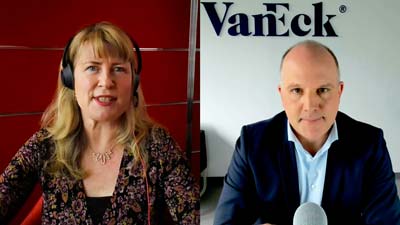Rolle im Portfolio
The iShares Core S&P 500 is best suited as a core building block for a portfolio, providing broad exposure to many of the largest companies in the world’s biggest economy. With 500 large cap constituents, the S&P 500 Index covers three-quarters of the U.S. equity market and is well diversified by sector and security. Increasingly, the underlying companies themselves are becoming geographically diversified, getting more and more of their revenue from outside the United States. Over the last 15 years, the S&P 500 has had an annualised volatility of 15.5%, versus 19.4% for the MSCI Europe and 23.7% for the MSCI Emerging Markets. During the same period, it has shown a correlation to the MSCI Europe index of 88%, and to the MSCI Emerging Markets index of 68% (both measured in local currency).
U.S. equities comprise a large portion of many global equity indices, making up over half of the MSCI World Index. So combining this fund with a global product might result in an overweight to U.S. equities. It would therefore work better in conjunction with a Europe, Australia and Far East (EAFE) or World ex-U.S. exposure.
The fund does not distribute any of the dividends paid by its underlying constituents, instead reinvesting them immediately to maintain full exposure. Therefore, this product may not suit an investor looking for regular investment income.
Fundamentale Analyse
Five years after the global financial crisis, the U.S. economy has taken the lead of countries on the path to economic recovery. With the S&P 500 reaching all-time highs this year, the financial market nosedive in 2008 and the subsequent Troubled Asset Relief Program (TARP), which bailed out AIG, Bank of America and Citigroup and rescued the automotive industry giants, seem like a distant memory.
GDP growth, however, has yet to regain its pre-crisis stride. While it accelerated throughout 2013, it lost significant momentum in early 2014 and remains well below the 3% average annualised pace of the last 30 years. Many have blamed the tepid numbers on an especially cold winter across the country which disrupted businesses and severely damaged crops in many states. But more granular economic indicators suggest the economy is still recovering, albeit more sluggishly than forecasted in 2013. Specifically, consumer and business expenditures have gone up and the unemployment rate has steadily declined, dropping below 7%, the lowest since the financial crisis began.
The housing market hit a rough patch in early 2014 with weak home sales numbers, all the while home prices have continued to rise year-on-year. The S&P/Case Shiller Home Price Index 20-city composite rose 12.9% in the 12 months through the end of February 2014, although it is still down about 20% from its 2006 peak.
Improved economic conditions led the Federal Reserve to start unwinding its quantitative easing (QE) programme in December 2013. The amount of monthly asset purchases has been reduced incrementally from $85 billion, but Janet Yellen has hinted at full normalisation of monetary policy remains a long-term prospect.
Meanwhile, the U.S. is in the early stages of a potentially game-changing energy revolution. The U.S. has become the world’s biggest gas producer, and the economy stands to benefit from a competitive advantage that follows the development of hydraulic fracturing technology, also known as fracking.
The S&P 500 has produced an annualised total return of 8.5% over the last 20 years. Like most equity indices in the world, the U.S. benchmark took a hit during the 2007-2008 financial crisis, but it has rallied considerably since then as successive rounds of quantitative easing have encouraged investors to move into risky assets. After bottoming out at 9.4 in February 2009, the price-to-earnings ratio of the S&P 500 year-to-date has been around 16-18.
Indexkonstruktion
The S&P 500 Index is a free float capitalisation-weighted portfolio of 500 large, United States-domiciled stocks. To join the index, constituents must meet minimum liquidity requirements, have a public float greater than 50% of the value of their stock and have market capitalisations above $4 billion. A committee maintains the index and meets regularly to review its underlying components, making changes on an as-needed basis. If a constituent falls out of line with any of the index’s entrance criteria, the committee can use its discretion to keep it in the index if the change is deemed temporary. New entrants to the index are also meant to maintain the sector balance of the broader eligible universe, as measured using the Global Industry Classification Standards (GICS®). The most significant sector exposures are information technology (18-20%), financials (15-17%) and health care (13-15%). Portfolio concentration is limited, with the top ten stocks in the index making up just 17-19% of its total. Top constituents are Apple (2-3%), Exxon Mobil (2-3%), and Google (1-3%).
Fondskonstruktion
The fund uses full physical replication to try to capture the performance of its benchmark, owning—to the extent possible and efficient—shares in all of the underlying constituents in the same weights as those of the index. The fund is Irish domiciled and has the U.S. dollar as its base currency. Dividends paid to the fund by its underlying holdings are immediately reinvested, rather than being distributed to the fund’s investors. This should reduce the cash drag that can result from accumulating dividends in advance of periodic distributions. The fund does not engage in securities lending.
Gebühren
The fund levies a total expense ratio of 0.07%, which is at the low end of funds offering similar exposure. Other costs potentially borne by the unitholder but not included in the total expense ratio include transaction costs on the infrequent occasions when the underlying holdings change, and bid-ask spreads and brokerage fees when buy and sell orders are placed for ETF shares.
Alternativen
Many providers offer ETFs tracking the S&P 500 Index, including ComStage, HSBC, db x-trackers, Lyxor, Source, Amundi, SPDR, Vanguard, and UBS. The Source S&P 500 ETF has the lowest fees, with a TER of 0.05%. The iShares Accumulating fund has a competitive TER of 0.07%, although the iShares S&P 500 Income ETF charges a hefty 0.40%.
Die in diesem Artikel enthaltenen Informationen dienen ausschließlich zu Bildungs- und Informationszwecken. Sie sind weder als Aufforderung noch als Anreiz zum Kauf oder Verkauf eines Wertpapiers oder Finanzinstruments zu verstehen. Die in diesem Artikel enthaltenen Informationen sollten nicht als alleinige Quelle für Anlageentscheidungen verwendet werden.

















